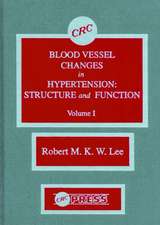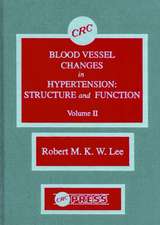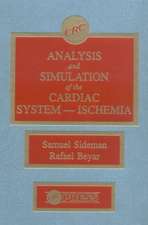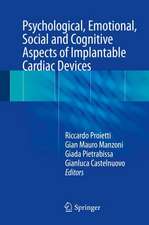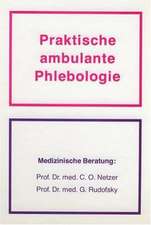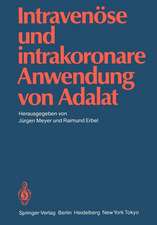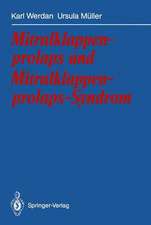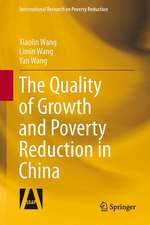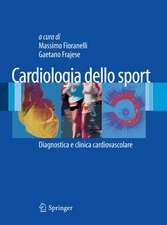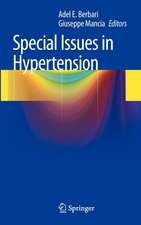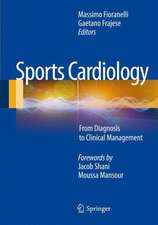Cardiac Electrophysiology Without Fluoroscopy
Editat de Riccardo Proietti, Yan Wang, Yan Yao, Guo Qiang Zhong, Shu Lin Wu, Félix Ayala-Paredesen Limba Engleză Hardback – 19 iul 2019
Cardiac Electrophysiology Without Fluoroscopy offers a thorough description of the technique correlated to the performance of EP procedure without the use of radiation, and provides a valuable resource for those seeking a practically applicable guide on how to perform cardiac EP without fluoroscopy, including practising and trainee electrophysiologists, cardiac imagers, general cardiologists and emergency medicine physicians.
| Toate formatele și edițiile | Preț | Express |
|---|---|---|
| Paperback (1) | 712.20 lei 38-44 zile | |
| Springer International Publishing – 15 aug 2020 | 712.20 lei 38-44 zile | |
| Hardback (1) | 968.86 lei 38-44 zile | |
| Springer International Publishing – 19 iul 2019 | 968.86 lei 38-44 zile |
Preț: 968.86 lei
Preț vechi: 1019.84 lei
-5% Nou
Puncte Express: 1453
Preț estimativ în valută:
185.43€ • 192.84$ • 155.17£
185.43€ • 192.84$ • 155.17£
Carte tipărită la comandă
Livrare economică 11-17 martie
Preluare comenzi: 021 569.72.76
Specificații
ISBN-13: 9783030169916
ISBN-10: 303016991X
Pagini: 630
Ilustrații: VI, 245 p. 87 illus., 85 illus. in color.
Dimensiuni: 178 x 254 mm
Greutate: 0.59 kg
Ediția:1st ed. 2019
Editura: Springer International Publishing
Colecția Springer
Locul publicării:Cham, Switzerland
ISBN-10: 303016991X
Pagini: 630
Ilustrații: VI, 245 p. 87 illus., 85 illus. in color.
Dimensiuni: 178 x 254 mm
Greutate: 0.59 kg
Ediția:1st ed. 2019
Editura: Springer International Publishing
Colecția Springer
Locul publicării:Cham, Switzerland
Cuprins
Clinical Studies of a purely 3D Navigation in Interventional Managements of Tachyarrhythmia.- Radiation exposure and safety for the electrophysiologist.- Ablation Energy Sources-Principles and Utility in Ablation without Fluoroscopy.- 3D mapping and reduction in radiation exposure.- Catheter Placement and Model reconstruction.- Learning curve for zero-fluoroscopic procedure.- Atrioventricular Nodal Reentrant Tachycardia (AVNRT) with zero-fluoroscopic procedure.- AV Nodal re-entrant tachycardia ablation without fluoroscopy.- Non-Fluoroscopic Catheter Ablation of Accessory Pathways.- Focal atrial tachycardia.- Ablation of atrial flutter with zero fluoroscopy approach.- Non-Fluoroscopic Catheter Ablation of Atrial Fibrillation.- Non-Fluoroscopic Catheter Ablation of Idiopathic Ventricular Arrhythmias.- Ventricular Tachycardia with Structural Heart Disease.- Reduction on radiation exposure in pediatric population undergoing ablation procedures.- Complications of RFCA and Prevention Method.- Safety of zero-fluroscopic procedure during pregnancy.- Cost optimization when using 3-D mapping systems for a non fluoro EP lab.- Zero-fluoroscopic implantation of cardiac electronic Device.- Cardiac Resynchronization Therapy (CRT) guided by 3D mapping system.- Transesophageal Electrophysiological Study without fluoroscopy.
Notă biografică
Riccardo Proietti MD, PhD, is a Cardiology Consultant at Luigi Sacco Hospital, Italy. His main focus is in cardiac electrophysiology and pacing. He gained a fellowship in Clinical Cardiac Electrophysiology at McGill University. He is FESC, and has also published several papers in international peer-reviewed journals.
Yan Wang, MD, PhD, has been a Cardiology Consultant since 2009, and a Medical Director since 2012 at Tongji Hospital, China. He specialises in clinical electrophysiology. He completed his postgraduate training at Huazhong University of Science and Technology, Hongkong University, and his fellowship at the Texas Cardiac Arrhythmia Institute in the USA.
Yan Yao, MD, PhD, FHRS, is the Peking Union Professor at Fuwai Hospital of Chinese Academy of Medical Sciences, Beijing, China. He has performed nearly 20,000 cases of catheter ablation and started ‘Total 3D Mode’ in March 2011. He is also a pioneer in catheter ablation of Brugada syndrome, and in vasovagal syncope. He has published over 30 papers in SCI enrolled journals.
Guo Qiang Zhong, MD, PhD, is the Director of the Department of Cardiology, The First Affiliated Hospital of Guangxi Medical University, China. His main specialisations are in cardiac electrophysiology and pacing. He has worked as a research scholar and doctor at Krannert Institute of Cardiology, Indiana University–Purdue University School of Medicine, USA
Felix Ayala-Paredes, MD, PhD is an Associate Professor of Cardiology at the University of Sherbrooke in Quebec, Canada. He gained his Medical, Cardiology and PhD degrees at the Universidad Nacional de La Plata, Buenos Aires, Argentina. He trained in electrophysiology at the Montreal Heart Institute and then founded and directed the Electrophysiology Service at the Sherbrooke University Hospital since 2002. He has been awarded the Magdy Basta award by the CHRS (Canadian Heart Rhythm Association) for his contributions to research in Canada. He is a founding member of the Canadian Working Group for Radiation Reduction in Arrhythmia Management.
Shu Lin Wu, MD, PhD, is the Director of the Guangdong Provincial Cardiovascular Institute, China. He specialises in cardiac electrophysiology and pacing. He completed his PhD of Medicine at Sun Yat-sen University of China, and is a member of the Heart Rhythm Society (HRS) and the European Society of Cardiology (ESC). He has performed over 10000 procedures of RFCA in cases with tachycardia especially with AF and VAs.
Yan Yao, MD, PhD, FHRS, is the Peking Union Professor at Fuwai Hospital of Chinese Academy of Medical Sciences, Beijing, China. He has performed nearly 20,000 cases of catheter ablation and started ‘Total 3D Mode’ in March 2011. He is also a pioneer in catheter ablation of Brugada syndrome, and in vasovagal syncope. He has published over 30 papers in SCI enrolled journals.
Guo Qiang Zhong, MD, PhD, is the Director of the Department of Cardiology, The First Affiliated Hospital of Guangxi Medical University, China. His main specialisations are in cardiac electrophysiology and pacing. He has worked as a research scholar and doctor at Krannert Institute of Cardiology, Indiana University–Purdue University School of Medicine, USA
Felix Ayala-Paredes, MD, PhD is an Associate Professor of Cardiology at the University of Sherbrooke in Quebec, Canada. He gained his Medical, Cardiology and PhD degrees at the Universidad Nacional de La Plata, Buenos Aires, Argentina. He trained in electrophysiology at the Montreal Heart Institute and then founded and directed the Electrophysiology Service at the Sherbrooke University Hospital since 2002. He has been awarded the Magdy Basta award by the CHRS (Canadian Heart Rhythm Association) for his contributions to research in Canada. He is a founding member of the Canadian Working Group for Radiation Reduction in Arrhythmia Management.
Shu Lin Wu, MD, PhD, is the Director of the Guangdong Provincial Cardiovascular Institute, China. He specialises in cardiac electrophysiology and pacing. He completed his PhD of Medicine at Sun Yat-sen University of China, and is a member of the Heart Rhythm Society (HRS) and the European Society of Cardiology (ESC). He has performed over 10000 procedures of RFCA in cases with tachycardia especially with AF and VAs.
Textul de pe ultima copertă
This book reflects how the concern regarding the effects of radiation exposure in patients and health personnel involved in cardiac electrophysiology (EP) has inspired new developments in cardiac electrophysiology procedures without the use of fluoroscopy. This innovative method has become a subspecialty within electrophysioloy with several EP laboratories around the world adopting an exclusive non-fluoroscopy approach. It features guidance on how to use three dimensional (3D) navigation systems, ablation energy sources and zero-fluorospic implantation of cardiac electronic devices. The potential complications and associated preventative methods with utilising RFCA are also described.
Cardiac Electrophysiology Without Fluoroscopy offers a thorough description of the technique correlated to the performance of EP procedure without the use of radiation, and provides a valuable resource for those seeking a practically applicable guide on how to perform cardiacEP without fluoroscopy, including practising and trainee electrophysiologists, cardiac imagers, general cardiologists and emergency medicine physicians.
Cardiac Electrophysiology Without Fluoroscopy offers a thorough description of the technique correlated to the performance of EP procedure without the use of radiation, and provides a valuable resource for those seeking a practically applicable guide on how to perform cardiacEP without fluoroscopy, including practising and trainee electrophysiologists, cardiac imagers, general cardiologists and emergency medicine physicians.
Caracteristici
Focuses on three-dimensional mapping of the electrical activity of the heart Reveals the essential techniques on this important procedure Contains contributions written by experts of the technique who have contributed to the development of the technique


